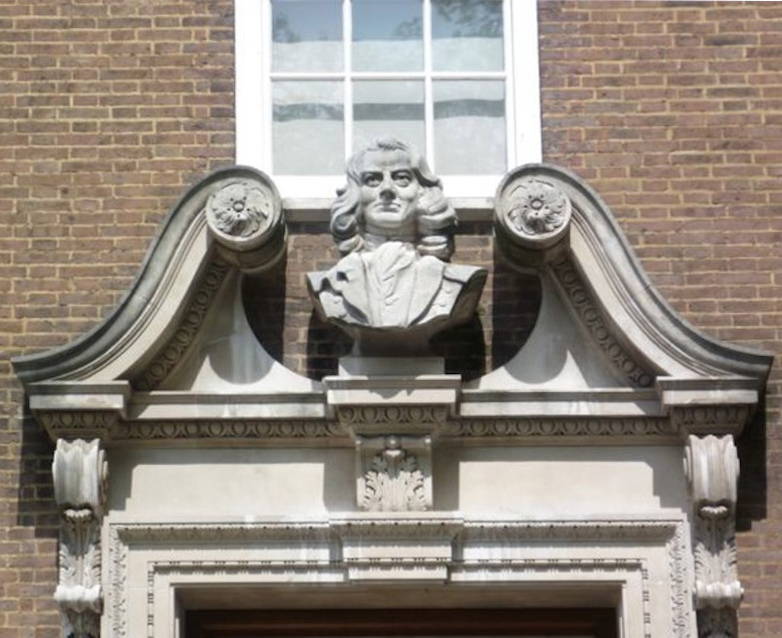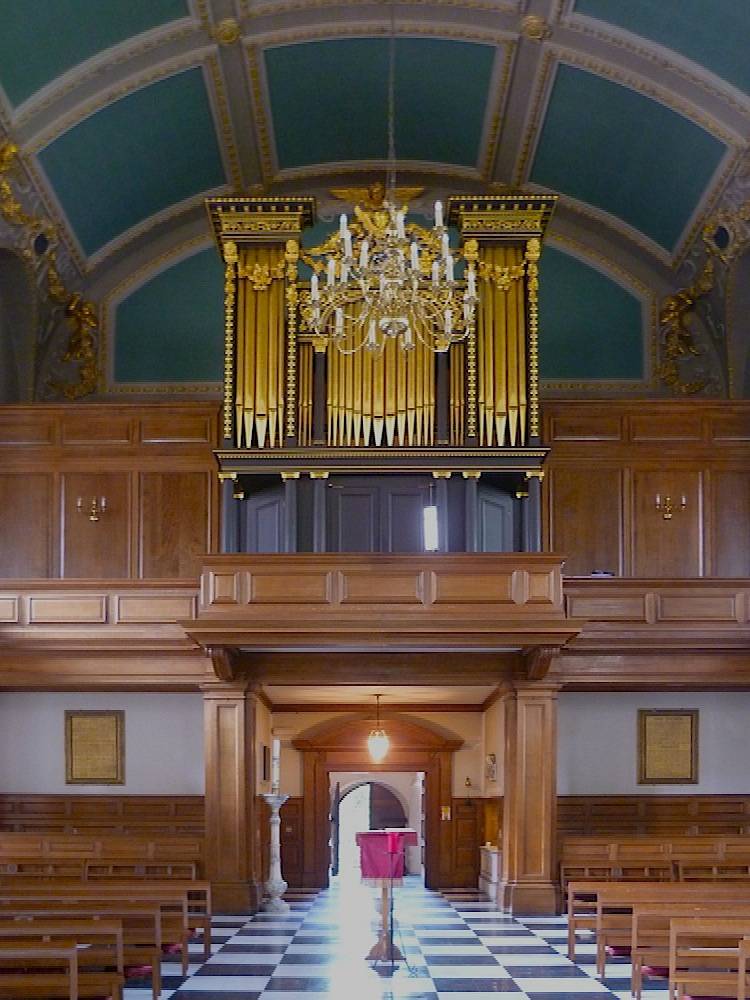
This bust of Thomas Coram, by the sculptor David Evans (1893-1959), presides over the doorway of the Foundling Museum at 40, Brunswick Square, London WC1N 1AZ. It dates from 1937 (see Weinreb et al. 869).
In his last years, Thomas Coram would visit the London Foundling Hospital, standing as godfather to some of the new babies. He was also remembered for distributing gingerbread to "his" boys and girls there. Hogarth's wonderful portrait of him continued to hang in the Hospital's dining hall, "and many of the children thought of him as their father" (Wagner 196). But by the time he died he had had nothing to do with the running of the institution for almost ten years, having been excluded from its administration early on, for speaking out against mismanagement and irregularities. This seems to have been typical of the bluff and forthright seaman. He had continued to busy himself with worthy causes, trying in particular to get another Foundling Hospital built. But, as it says on his memorial stone, he had been "little attentive to his Private Fortune," and was "poor in Worldly Estate." As one biographer puts it baldly: "Wealth at death: next to none" (Taylor). Nevertheless, when he died in 1751 at the ripe old age of 84, he left behind him something much more valuable than money.
First, there was the Hospital itself. This continued to take in children on the original site until 1926. By then, however, the grand old building was surrounded by roads and other buildings instead of fields, and the busy railway stations nearby had brought more pollution. The governors at last acted on William Acton's complaint of 1859, that the children were being "unnecessarily reared in the atmosphere of the metropolis" (505). They moved the children further out of London, first to Redhill in Surrey, then to a fine new building at Berkhamsted in Hertfordshire. This was the last home of the Foundling Hospital, which so many children had entered since that first spring evening in 1741: the last admission number for 1901, the last year of Queen Victoria's reign, was 22,752 (see the London Metropolitan Archives' records). As an institution, it was closed down completely in 1954. The remaining children either went back to their birth mothers, or were fostered or adopted. The Berkhampsted building was then used by Ashlyns School, with the older living accommodation being converted to classrooms and laboratories.


Left: Thomas Coram's tomb chest in St Andrew's Church, Holborn. Right: The organ casing at St Andrew's comes from the organ donated to the Foundling Hospital by Handel.
Coram's memorial stone can still be found in the chapel at Berkhamsted, but Coram himself was re-interred at the back of St Andrew's Church, Holborn, in walking distance of the Hospital's original site in Bloomsbury. His tomb chest, shown above, is in an alcove between the west entrance vestibule and the nave. On the wall in this area is a stone plaque from an older monument, with a carved relief of putti faces; a small stone sculpture on the chest itself shows another more realistic-looking putto rubbing his eyes, and on the front of this otherwise simple chest are the heraldic motifs designed for the Foundling Hospital by Handel: the compassionate Diana of Ephesus and Britannia support a shield depicting an infant beneath the night sky, with the Lamb of God above, and the simple motto "Help" below (for these devices in another setting, see the beginning of Part Three). Also in church are the font of 1804, and mid-nineteenth-century pulpit, from the old school chapel, as well as the "modest Kentish case" from the original organ donated to the Hospital by Handel, possibly designed by the Hospital's architect, Theodore Jacobsen (see Bradley and Pevsner 56). Nothing could be more appropriate: the church later became the headquarters of the London College of Organists, though this has since moved to Birmingham.

The Foundling Museum, in "a quiet neo-Georgian house of 1937 by J.M.Shepherd" (Cherry and Pevsner 269); in fact, the architects were J. M. Sheppard & Partners, whose address around this time was in Bedford Place, Bloomsbury ("Basic Biographical Details"; see also "Ashlyns School Building").
Although the old building in London was demolished, some important elements of it were carefully dismantled and preserved. These include the original Court Room and the great oak staircase of the boys’ wing, which have been reassembled in the present Foundling Museum. The latter leads up to the first floor exhibits. In this way, something of the original structure survives to this day. Many of the institution's treasures also survive and have been gathered here too, such as the copy of the Messiah that Handel left to the Hospital, and paintings by Hogarth (including the famous one of Coram himself) and other important artists.


Left: Plaque set into the pier of the old gateway, explaining the historical background to Coram's Fields (enlarge to see better). Right: Coram's Fields today.
More importantly, the Hospital's spirit lives on in the work of what is now known simply as "Coram." Fortunately, there are no longer huge throngs of "exposed and deserted children" on our streets, and no one now wants to keep children in a big home, however warm-hearted their carers might be, any more than they would want to send them off abroad for doing something wrong, or simply to make room for more children. Today, Coram has a campus just across from the Foundling Museum, and runs many projects involving large numbers of children of all ages, and several thousand families. Its methods have changed, and, continuing on from the closure of the Hospital, it provides adoption and foster services, as well as recreational and other facilities. Although the time for institutionalizing children has passed, in a very general sense, the charity's aim is what it has always been — to support youngsters facing the challenges of their times, so that they can find a place in society and make a contribution to it. In the organization's own words: “We help young people prepare for independence, manage their health, well being and finances, and pursue educational and work opportunities." Of course the assumption that those opportunities will be limited has now gone. There are many brilliant success stories of twenty-first century "Coram's children" who are really making the most of their adult lives.
Most important of all is Thomas Coram's wider legacy. It is the hardest to quantify, since it consists of the work of all those people who followed his lead and formed other charitable organizations, which have helped people right down the ages, and all over the world. Ruth McClure puts it very well: "The Hospital's organizational form and many of its fund-raising techniques were repeatedly imitated by its successors, both in England and America, during the next two centuries.... Every such institution is, in a sense, 'a child of this Hospital'" (248).
Last modified 11 May 2016